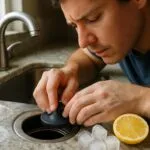Most families have battled a grimy tub or stubborn soap scum that laughs at dish soap. With so many cleaning products in the aisle, it is easy to feel unsure, especially with kids or pets in the house.
Contents:
- Key Takeaways
- Understanding the Importance of Choosing the Right Cleaner
- Types of Cleaners for House Cleaning
- Specialty Cleaning Products
- Tools and Equipment for House Cleaning
- Factors to Consider When Selecting a Cleaner
- Popular Brands and Products to Consider
- Tips for Safe and Efficient Cleaning
- Conclusion
- FAQs
Reflect on your daily use of cleaning products and consider which ones best support your routine.
Some sprays can irritate lungs or skin, and a few raise longer-term health concerns. Parents want tools that clean well and keep the home safe. This guide explains cleaner types, how to read labels, and which options earn better safety marks.
Find out how to pick between liquid dish soap and a heavy-duty degreaser, choose laundry items that avoid flareups, and store supplies in safer ways. The right pick saves time, money, and hassle. A cleaner home really is closer than it seems.
Key Takeaways
- Mixing harsh ingredients like bleach and ammonia can trigger dangerous fumes that irritate lungs or raise cancer risks; 6,300 home poisonings were linked to chemical reactions in 2023.
- According to a guide, brands like Mrs. Meyer’s Clean Day, Fabuloso Multi-Purpose Cleaner, and The Pink Stuff rate well for clarity and performance.
- Storing cleaners up high with childproof latches can prevent most accidental poisonings in homes with kids or pets, based on recent safety guidance.
- Use gloves and eye protection, and never mix bleach with vinegar or ammonia. These basics are top safety tips from health experts.
Understanding the Importance of Choosing the Right Cleaner
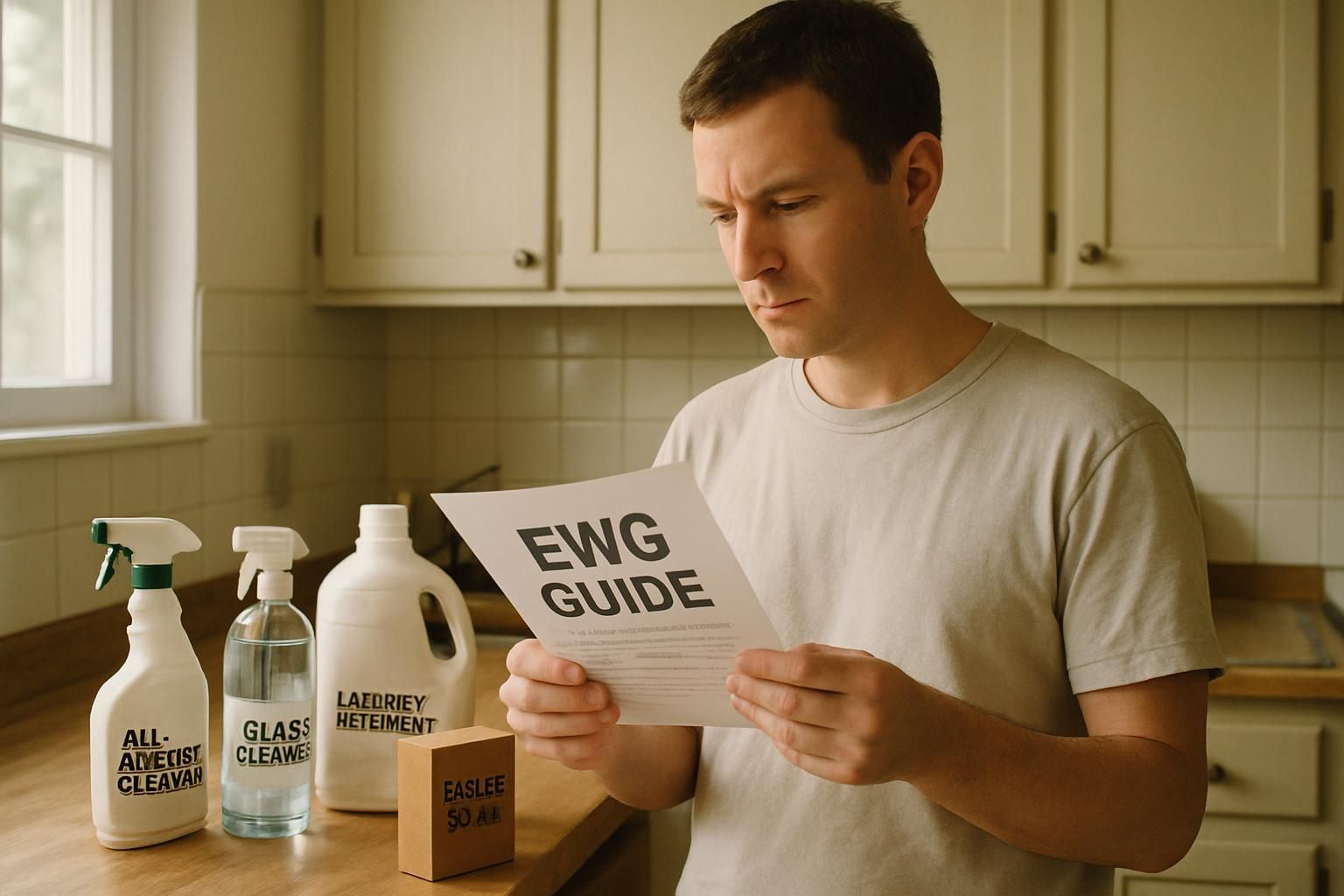
Some cleaners leave more than shine behind. Certain ingredients can trigger asthma, burn skin, or create long-term risks. Many products still use vague terms and hidden fragrance mixes.
Labels do not always tell the whole story. Strong staples like bleach or ammonia can include other chemicals that irritate eyes and lungs. EWG VERIFIED appears only on products that meet strict health and safety standards. Better choices mean cleaner air and less worry during weekend chores.
Types of Cleaners for House Cleaning
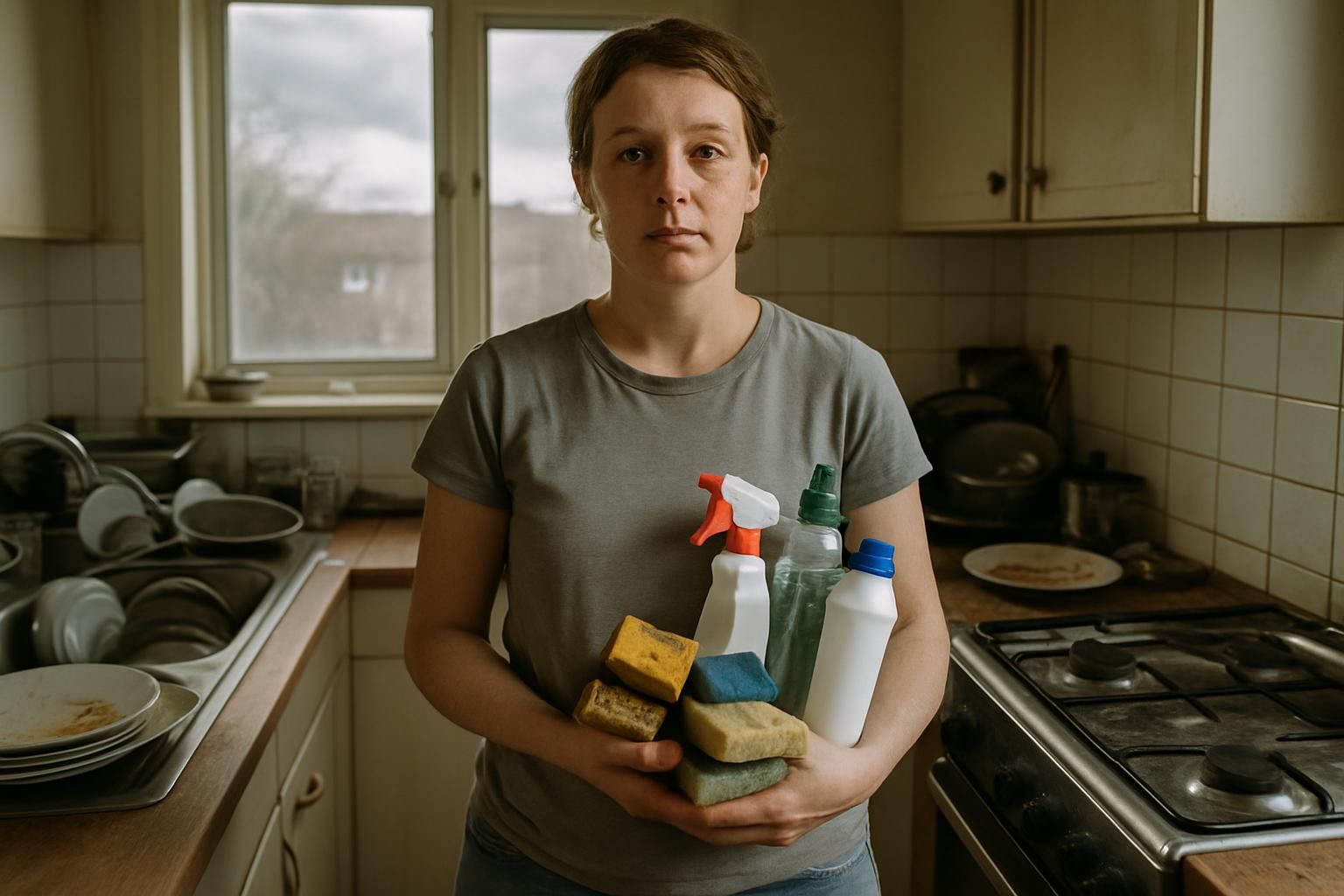
Some formulas cut grease, others make glass sparkle, and a few handle both jobs well. Tools matter too, from spray bottles to reusable sponges.
All-purpose Cleaners
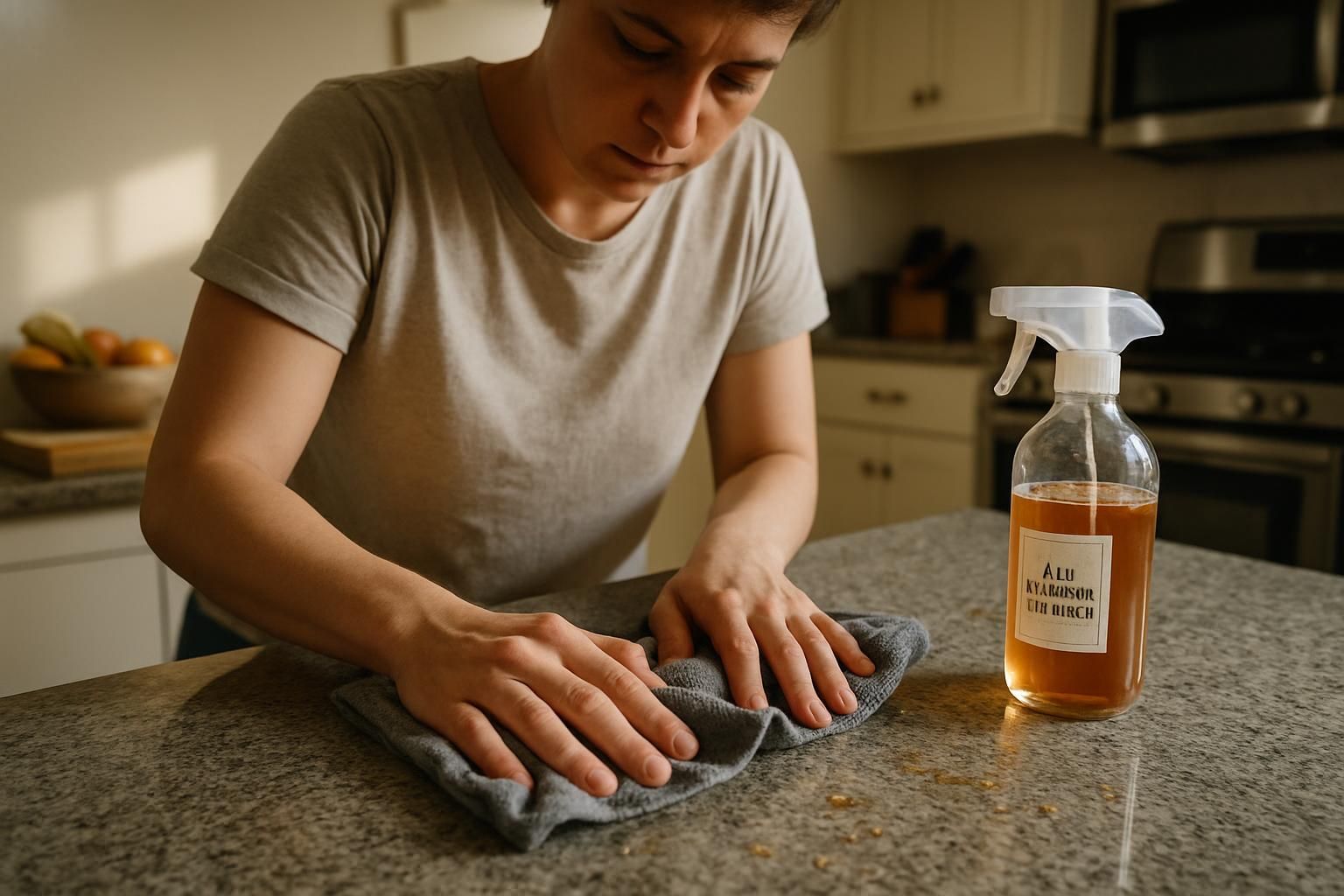
All-purpose cleaners tackle sticky counters, greasy stoves, and dusty shelves. Most work on sealed surfaces like tile, laminate, and finished wood. Many families like options such as Mrs. Meyer’s Clean Day or Fabuloso for strong results with clearer labels.
Newer formulas often skip some harsher substances. With more choices, parents can match safety, price, and cleaning power without guessing.
Disinfectant Cleaners

Disinfectant cleaners target germs on high-touch spots like counters, doorknobs, and bathroom sinks. EWG lists disinfectants separately and flags hazards tied to certain chemicals. One example is Quaternary ammonium compounds, a class of disinfectants that can irritate lungs and skin.
Labels often claim 99.9% germ kill. Still, the ingredients matter. Many families now prefer plant-based alcohols that meet EPA standards yet score lower on hazard scales. That balance helps parents clean fast without breathing in strong fumes.
Wiping with microfiber cloths boosts results and cuts waste. Popular brands keep adding options that hit both safety and effectiveness with less residue.
Degreasers
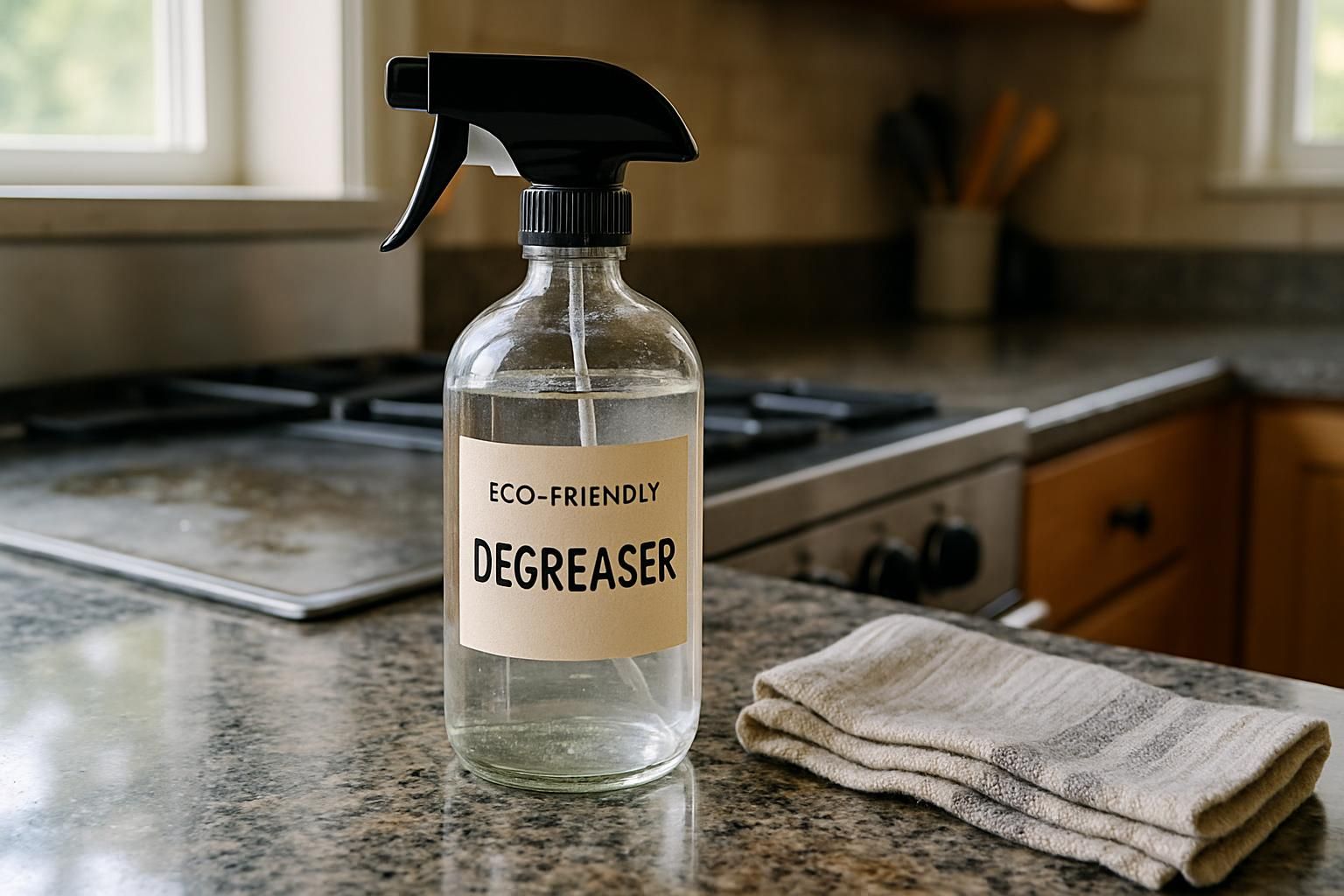
Kitchen messes cling to ovens, stove grates, and backsplashes. Degreasers break down oils so scrubbing takes minutes, not hours. These products can help the health and environmental impact, which helps parents avoid harsh leftovers around kids’ plates.
Spray-on picks like Method Heavy Duty or Goo Gone lift oil and sticky residue with less effort. Some eco-focused versions use plant-based solvents, which are ingredients that dissolve grease. Always follow label directions, especially with concentrates.
Glass Cleaners
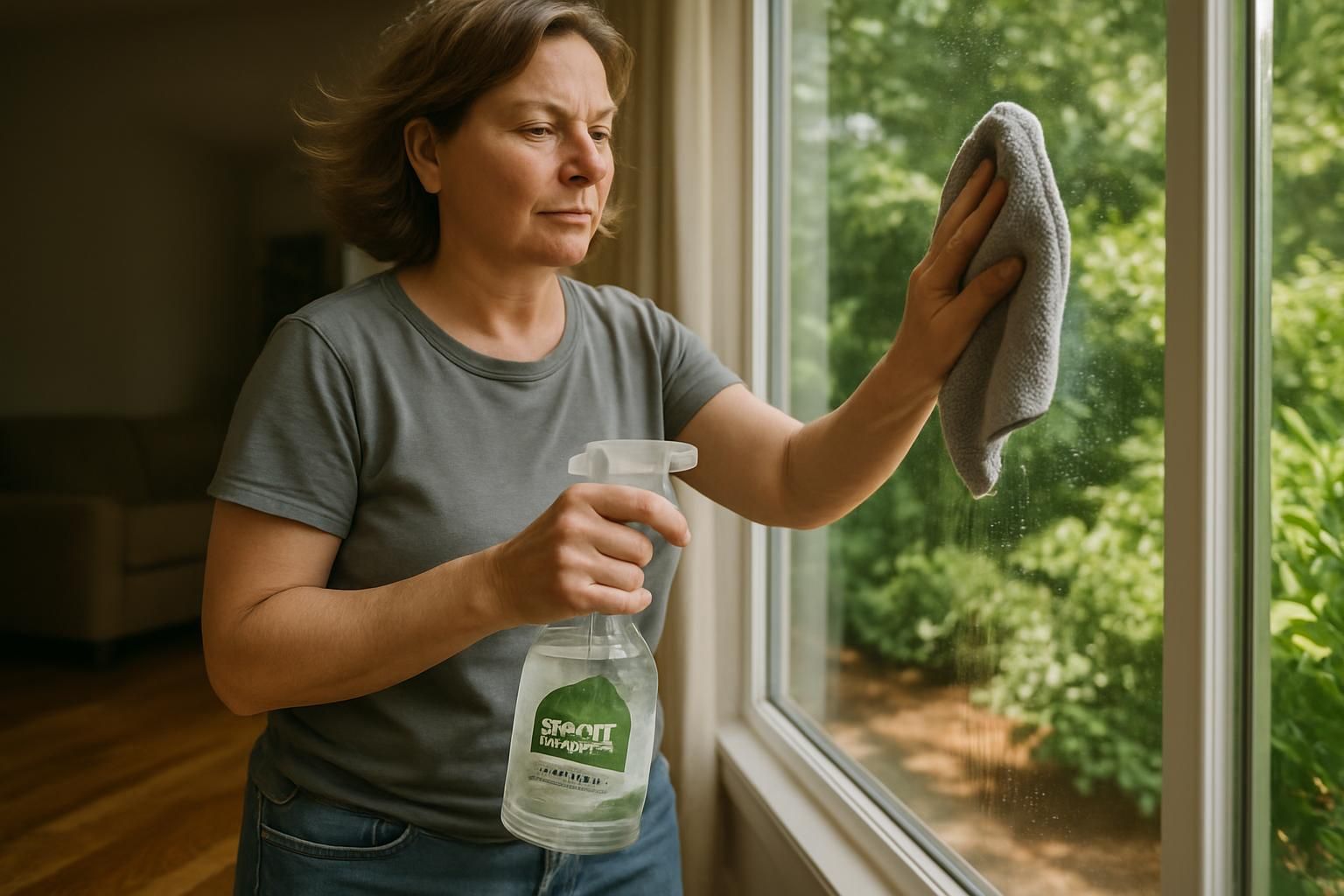
Clean windows brighten a room right away. Glass cleaners remove fingerprints, dust, and smudges. Families often look for formulas without ammonia to reduce eye and throat irritation.
It helps compare brands like Windex or Seventh Generation for safety data. Use a microfiber cloth to cut streaks and limit over-spray. Clearer labels make it easier to spot products that feel safer around kids and pets.
Floor Cleaners
Kids and pets test floors every day. That is why families want solutions that clean well without heavy fumes. Some reviews show how formulas perform on wood, tile, laminate, and carpet.
Carpet spot treatments and wood polishes each serve a purpose. Too much water can warp planks, and the wrong wax can dull a finish fast. Short ingredient lists and residue-free formulas often keep floors cleaner, longer.
Specialty Cleaning Products
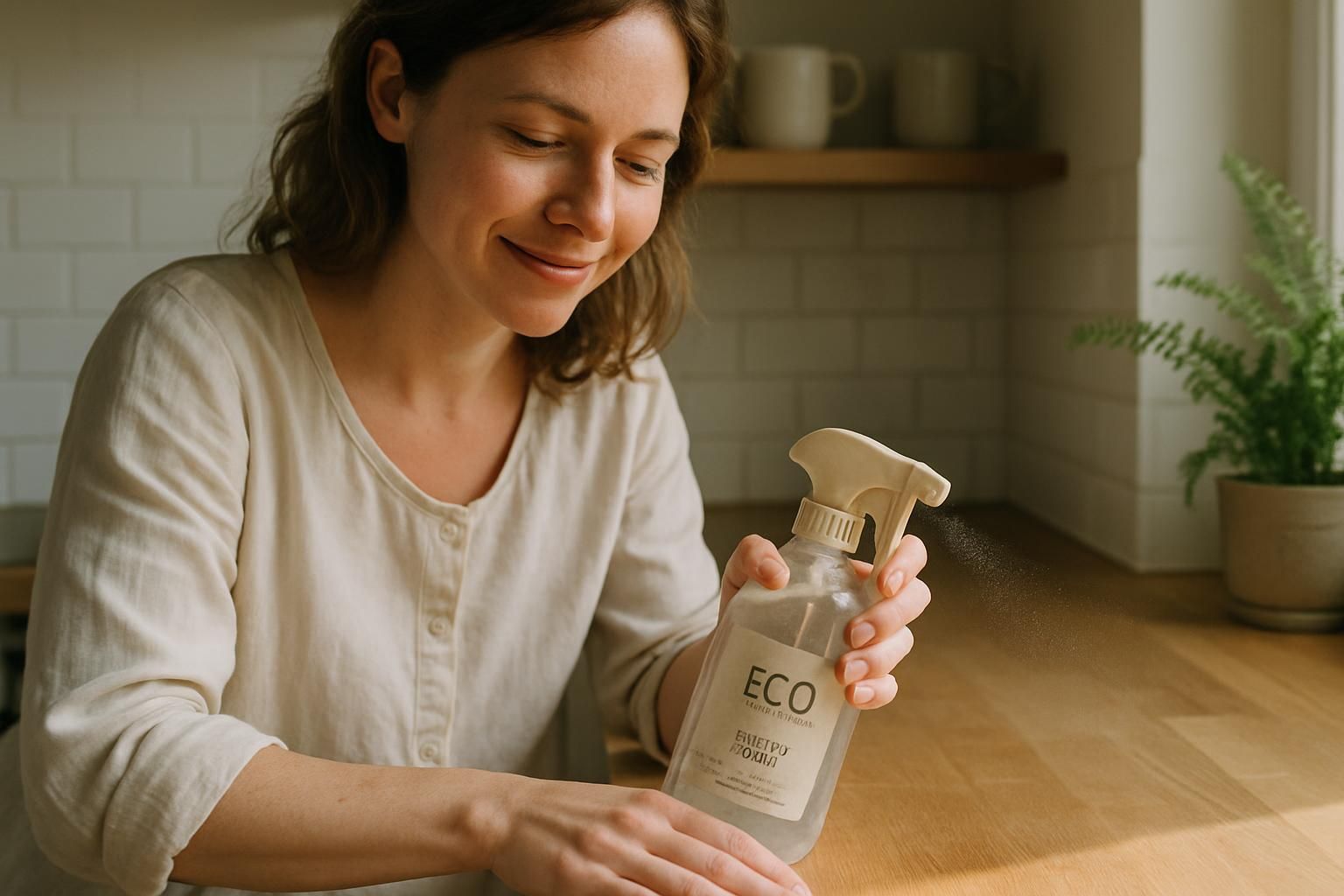
Some cleaners focus on allergies or pet safety so families can breathe easier. Others lean on natural ingredients and simpler formulas to reduce indoor air pollution.
Eco-friendly Cleaners
EWG rates cleaners for environmental and health impact using firm standards. Plant-based products like Mrs. Meyer’s Clean Day often avoid ingredients that harm indoor air or waterways.
Brands that list every ingredient support quick, informed choices. Swapping bleach wipes for vinegar or baking soda solutions can still leave counters clean and floors sparkling. Better picks protect kids, pets, and the planet with each swipe.
Pet-safe Cleaners
Pet-safe options protect curious noses and paws. Bleach and ammonia can bother animals, even at low levels. We warn that the word natural does not always mean pet-safe.
Look for full ingredient lists on stain removers, deodorizers, and daily sprays. Watch for risky essential oils and certain alcohols. When in doubt, hot water and a microfiber cloth can handle muddy paw prints without adding chemicals at all.
Hypoallergenic Cleaners
Hypoallergenic products skip common triggers like fragrances and dyes. That makes chores easier for families with allergies or sensitive skin. Clear labels and simple formulas reduce sneezes and rashes.
The ingredient glossary helps decode claims. Even if a bottle says allergy-friendly, it is smart to compare those words with a trusted guide. Fewer irritants mean fewer flareups after cleaning.
Tools and Equipment for House Cleaning
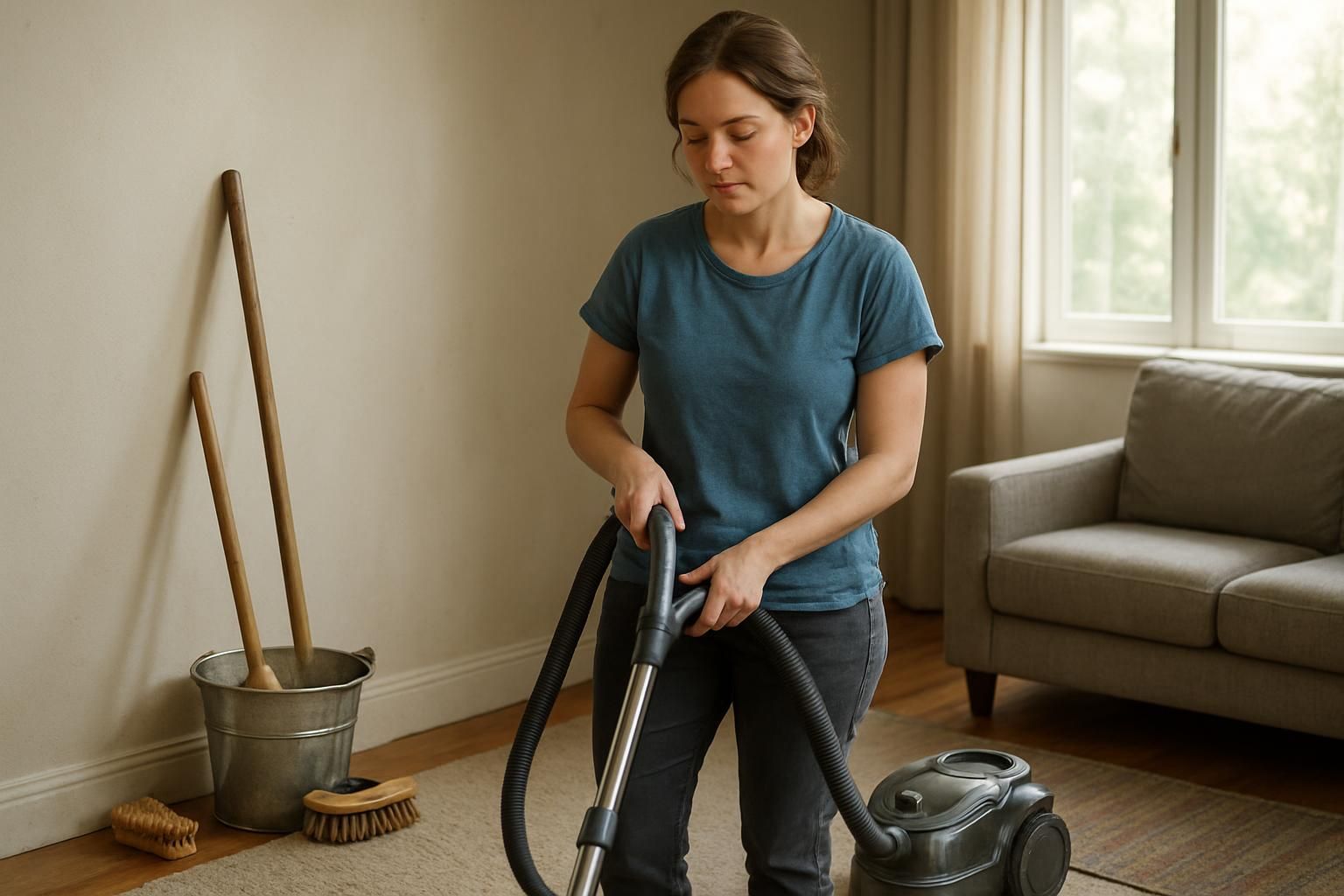
Reliable tools cut work time and boost results. Grab the right gear, then see which cleaner fits the job best.
Vacuum Cleaners
Vacuum cleaners pull up dirt, dust, and allergens from floors and rugs. Strong filtration traps pet dander and pollen inside the machine instead of pushing them back into the room. Pairing a vacuum with proper cleaning products keeps spaces fresh.
Maintain the vacuum for better suction. Empty the bin or replace the bag often to reduce odors and airflow clogs. Many parents notice fewer sniffles once dust and hair are captured and tossed.
Steam Cleaners
Steam cleaners use heated water to loosen grime without heavy chemical smells. Hot steam helps kill germs, dust mites, and some mold on hard surfaces and grout lines.
Parents like steam for high chairs and play tables after snacks. Cutting bottle use also reduces waste on the shelf. Many models are promoted as eco-friendly because they clean with only water.
Microfiber Cloths
Microfiber cloths act like magnets for dust and crumbs. They handle counters, glass, and bathroom fixtures with little or no extra spray. That means fewer chemicals and less waste than paper towels.
These cloths can be washed hundreds of times. A damp microfiber lifts sticky spills and leaves fewer streaks on stainless steel. Many households report using half as many cleaners after switching to quality microfiber.
Scrub Brushes
Scrub brushes handle stubborn grime in tubs, sinks, and grout. Pair a firm brush with the right cleaner to break up build-up faster. Keeping brushes clean is key, so wash them in hot soapy water or run plastic ones through the dishwasher.
Use separate brushes for kitchen and bathroom to avoid spreading germs. Pick a comfortable grip and check for worn bristles. Fresh bristles scrub better and save time.
Factors to Consider When Selecting a Cleaner
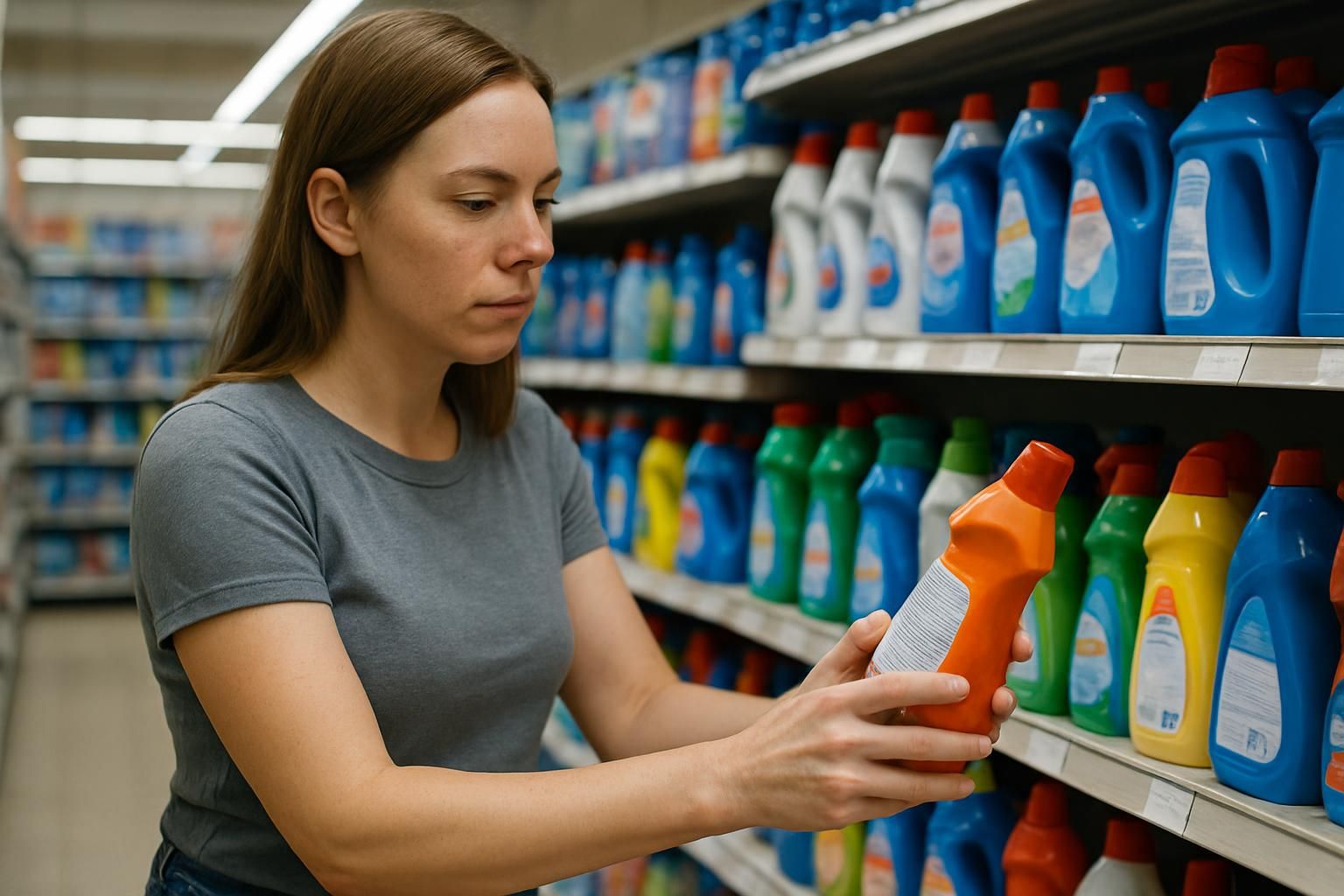
Choosing a cleaner is like picking the right shoes for the day. The match depends on the surface, the mess, and who lives in the home.
Surface Compatibility
No cleaner fits every surface. Mrs. Meyer’s Clean Day may treat wood gently but streak glass. The Pink Stuff buffs tile well yet is not a fit for polished wood or soft fabrics.
Carpets need one approach, tile and wood need different ones. Pet-safe labels help protect paws that roam counters and floors. When unsure, test in a small spot first to avoid damage.
Ingredients and Safety
Ingredients affect air, skin, and long-term health. A guide breaks down safety data so families do not have to guess. Chemists and health experts contribute to those reviews.
EWG VERIFIED means every ingredient passed strict standards. The glossary also explains complex label terms in plain English. Better picks keep counters ready for pizza night, with fewer hidden risks.
Effectiveness for Specific Tasks
Different jobs call for different tools. Degreasers handle baked-on messes in kitchens. Disinfectant sprays like certain Lysol products target 99.9% of common bacteria on bathroom surfaces, based on EWG’s recent ratings.
Stain removers like The Pink Stuff can tackle crayon marks and muddy paw prints. EWG ratings cover odor control, laundry stains, and virus kill claims. Check the app before shopping so each bottle matches the chore ahead.
Environmental Impact
What goes down the drain matters. Eco-friendly cleaners rely on ingredients that break down more easily and use packaging that reduces waste.
Today, more labels list biodegradability, recyclability, or carbon footprint details. Choosing smarter products can cut plastic trash and lower indoor toxins. Small choices add up over time.
Popular Brands and Products to Consider
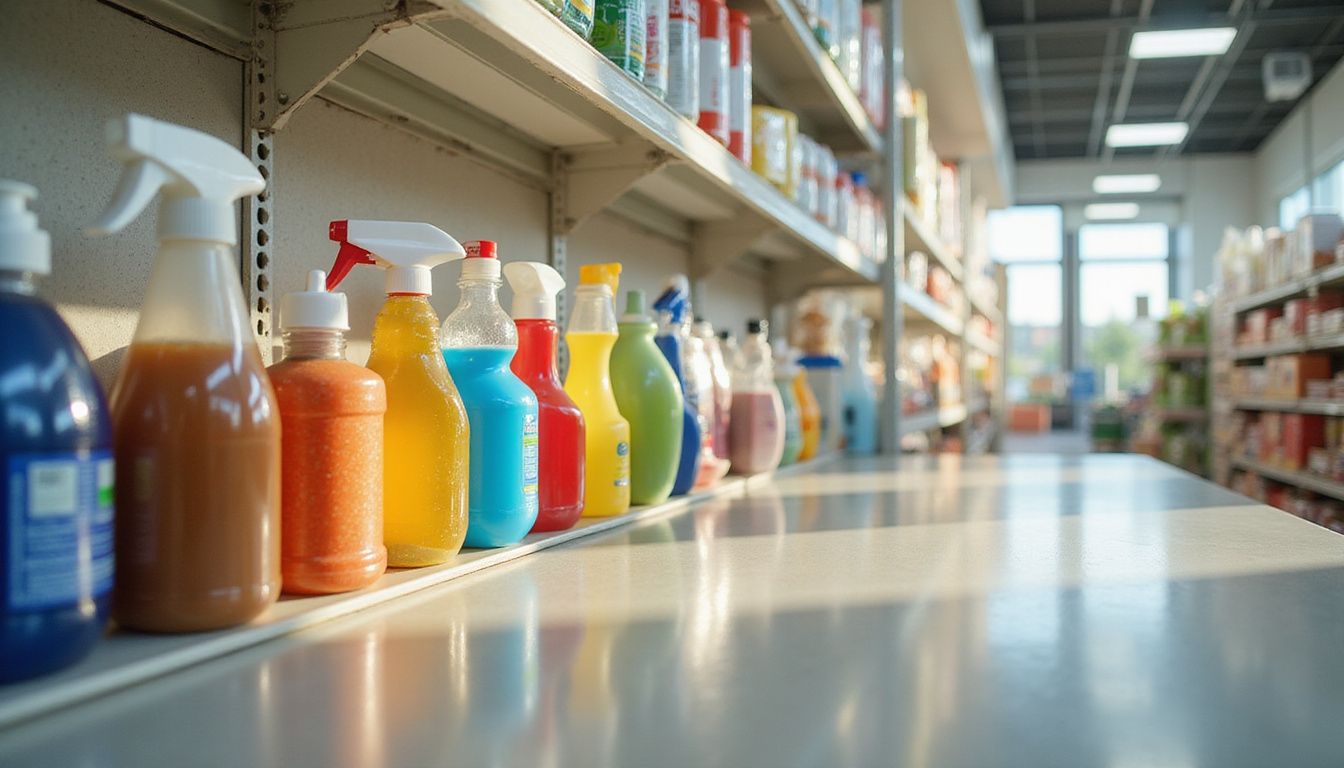
Many homes stick with brands that perform and share clear ingredient info. These picks often show up in safety apps and on best-of lists.
Mrs. Meyer’s Clean Day
Mrs. Meyer’s Clean Day stands out for plant-based ingredients and easy-to-read labels. Some apps lists many of its items, which helps parents check safety fast.
Shoppers like the fresh scents that do not overwhelm. Surfaces end up clean without sticky film after wiping. The brand balances effective house cleaning with better air quality indoors.
The Pink Stuff
The Pink Stuff has become a go-to for tough grime on pots, tiles, and sinks. EWG has evaluated the product for safety and transparency.
Its paste pairs well with scrub brushes or microfiber. A small amount can erase stubborn marks, which saves both time and effort. Many reviewers call it their quick win for messes that used to take ages.
Fabuloso Multi-Purpose Cleaner
Fabuloso Multi-Purpose Cleaner is popular for everyday messes in kitchens and bathrooms. Some apps lets shoppers scan the label and compare safety and performance on the spot.
Ingredient lists for each scent are simple to find. Many families like the light, fresh smell and streak-free shine. Reading recent reviews can help pick the best scent for the household.
Tips for Safe and Efficient Cleaning

Good habits prevent accidents and save time. Use gloves, store supplies out of reach, and build a simple routine that sticks.
Proper Storage of Cleaning Products
Store cleaners up high or in locked cabinets to protect kids and pets. Do not keep them under the sink where small hands explore. Clear labels on every bottle reduce mix-ups during busy nights.
Keep incompatible chemicals apart. For example, never place ammonia cleaners near chlorine bleach. Bins or locked totes in a laundry room make storage simple and safe.
Using Protective Gear
Safety gear is quick insurance. Nitrile gloves block harsh chemicals and common allergens. Add eye protection if using bleach or heavy-duty degreasers.
Masks help anyone sensitive to dust or fumes. These steps take seconds and prevent rashes, red eyes, and coughs. Simple gear, fewer surprises.
Avoiding Harmful Chemical Combinations
Bleach plus ammonia creates toxic fumes. In 2023, thousands of home poisonings were linked to chemical reactions like that. Bleach with vinegar can release chlorine gas, which is also dangerous.
Never mix strong cleaners unless labels say it is safe. Post a quick cheat sheet near storage shelves so everyone can double-check before cleaning day starts.
Conclusion
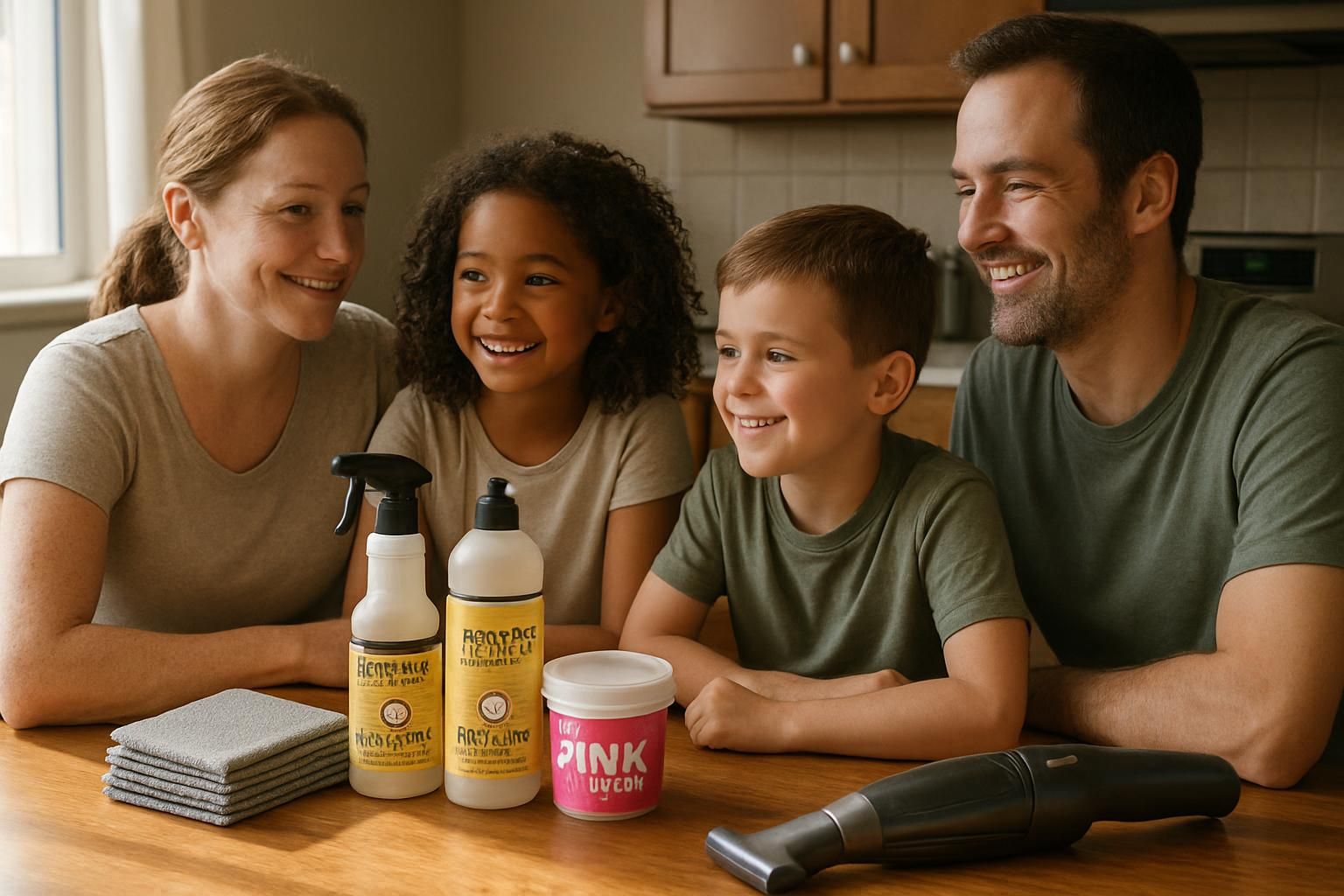
Finding the best cleaner does not require guesswork. With smart picks for all-purpose tasks, floors, and stains, families can get real results without harsh tradeoffs. Brands like Mrs.
Use safer storage, grab basic protective gear, and avoid mixing risky chemicals. Check EWG’s app, then choose cleaning products that match the job, the surface, and the people at home. Even liquid dish soap can be a hero for quick fixes when used well.
General guidance only, not medical advice. Always follow label directions, ventilate rooms, and call a professional or poison control if you are unsure or a reaction occurs.
FAQs
1. How do I find the best cleaner for house cleaning?
Start by asking friends or neighbors for recommendations. Check online reviews and ratings on trusted sites. Interview a few candidates to see if they fit your needs. Always ask about their experience with different types of homes.
2. What questions should I ask before hiring a house cleaner?
Ask how long they have cleaned houses like yours. Find out what supplies they use and if you need to provide anything special, such as allergy-friendly products or pet-safe cleaners. Ask about background checks and insurance too.
3. Should I hire an individual or go with a cleaning company?
Both options work, but each has pros and cons. Individuals may offer flexible schedules and lower rates; companies often bring teams, backup staff, and set procedures for quality control.
4. How can I make sure my home stays clean between visits?
Tidy up daily messes right away so dirt does not pile up like laundry in a teenager’s room after finals week! Wipe counters after meals, sweep high-traffic areas often, and keep clutter off floors to help your next deep clean go faster than lightning on race day.





